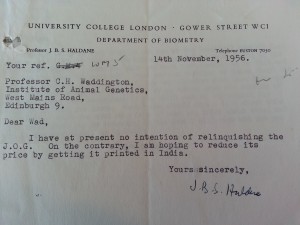 The C.H. Waddington collection contains a folder of correspondence with J.B.S. Haldane, who died 50 years ago this year, concerning the Journal of Genetics. The correspondence, which covers 1956 to 1957, expresses Waddington’s concern at the decision made by Haldane to take the Journal, of which he was editor, out to India with him when he retired.
The C.H. Waddington collection contains a folder of correspondence with J.B.S. Haldane, who died 50 years ago this year, concerning the Journal of Genetics. The correspondence, which covers 1956 to 1957, expresses Waddington’s concern at the decision made by Haldane to take the Journal, of which he was editor, out to India with him when he retired.
The Journal of Genetics had a long-standing, although somewhat fraught, relationship with Edinburgh’s Institute of Animal Genetics. Established in 1910 by two men who could be called the ‘founding fathers’ of the science in Britain, William Bateson (who coined the term ‘genetics’ to encompass its present scientific meaning), and Reginald Punnett (who held the first Chair of Genetics in Britain), it is the oldest English language journal in that field of science. However, in its first few decades it was felt to be inaccessible and somewhat limited in its publication remit by certain more experimental scientists, including those at the Institute of Animal Genetics. This was so much the case that the Institute’s director, F.A.E. Crew and his colleagues at the Institute, Julian Huxley, Lancelot Hogben and others, teamed together in 1923 to establish the Journal of Experimental Biology along with an associated Society of Experimental Biology. As hinted at in its title, the new Journal aimed to publish papers of a more experimental nature covering a wider range of genetical and evolutionary biology theories and hypotheses than covered by the Journal of Genetics at that time.
However, when editorship later passed to physiologist, geneticist, mathematician and general polymath J.B.S. Haldane, his remarkable breadth of interest and abilities and sharp, colourful personality transformed the Journal’s remit and potential (although Waddington claimed he was ‘a rather niggling editor about details and notoriously bad at answering letters’ [part of GB 237 Coll-41/5/2/9 ]).
However, when Haldane decided to retire to India in the late 1950s, where he would become a naturalised citizen, his decision to take the Journal with him caused some consternation in Britain. Waddington, who was Crew’s successor as director of the Institute of Animal Genetics, felt that the editorship should pass over to him and his colleagues and that for Haldane to continue in India would be ‘chaotic’. But Haldane would not be dissuaded, writing with characteristic wryness to Waddington on 19 January 1957:
You can, of course reply that I am an old man and may soon die or lose such intellectual powers as I still possess. I may. But my systolic pressure is 120-130mm Hg. And I have not lost a day’s university teaching through illness since 1930. And meanwhile a thermonuclear bomb or a major economic crisis may affect British publication. When I die or become too senile to edit, there need be no more difficulty in transferring the Journal back to Britain than in transferring it to India.
(part of GB 237 Coll-41/5/2/9).
Following Haldane’s death in 1964, his widow Helen Spurway continued publication in India with Madhav Gadgil, H. Sharat Chandra and Suresh Jayakar until she died in 1977. In 1985, the Indian Academy of Sciences resumed publication of the Journal, which still continues to this day in association with Springer publishing.
Look out for a longer piece here on J.B.S. Haldane late this year!
